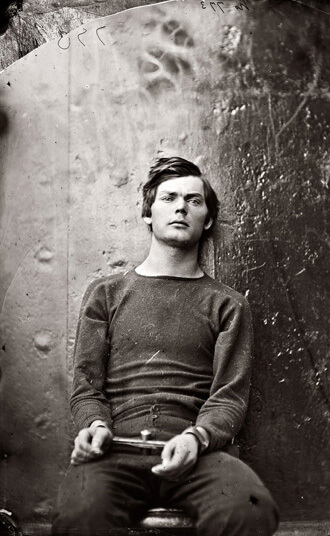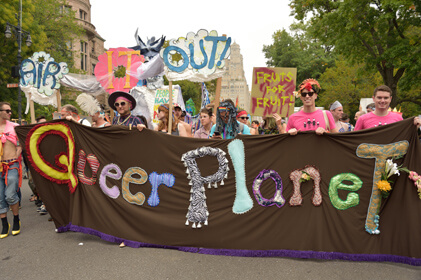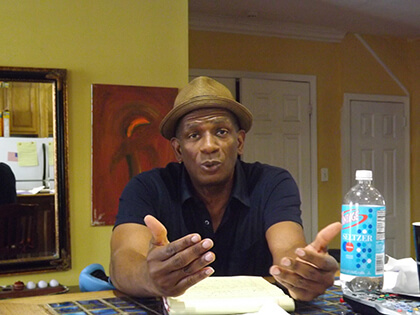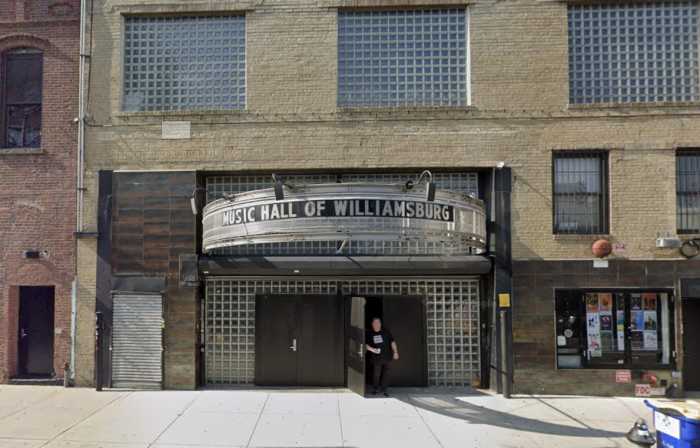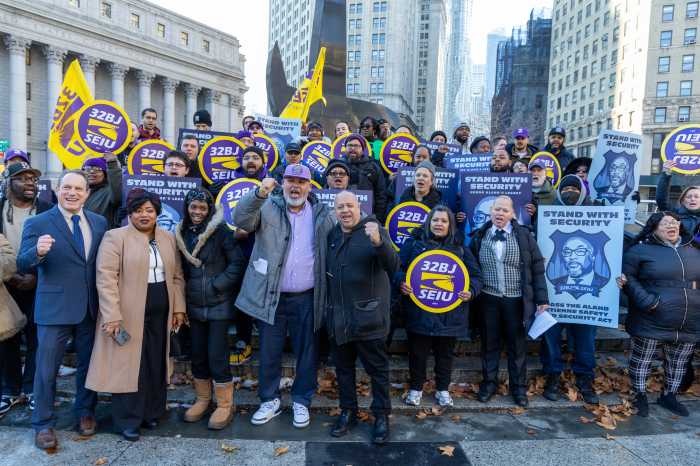ILLUSTRATION BY MICHAEL SHIREY | ORIGINAL PHOTOS BY JEAN CARLOMUSTO, DAVID SHANKBONE/ WIKIMEDIA COMMONS
In the spring of 1989 I went to New York — a city I was born in but left for Los Angeles in 1976 — and paid a visit to my old Gay Activists Alliance compadre Vito Russo, for what would prove to be the last time. I was in town to do research for my book “The Scorsese Picture: The Art and Life of Martin Scorsese,” which would be published three years later and dedicated to Vito’s memory.
Like countless other invaluable gay men in 1989, Vito was dying of AIDS. As always his spirits were high and we laughed uproariously together at all manner of human folly, gay and straight, past and present. His admiration for Larry Kramer was one of the few really serious topics we discussed that day. It wasn’t until I was out the door and down the stairs that the sadness overwhelmed me. So I went to visit Larry, whose health was reportedly little better than Vito’s.
Medically speaking that may have been the case. But the man who stood before me at the door of his One Fifth Avenue condo appeared neither beaten nor bowed. I wanted to check in on what Larry was up to for many reasons, one of which concerned the fact that sometime around 1981 he had begun working on a project entitled “The American People” — an “alternative history,” as the saying goes, of the nation from a gay perspective, bringing to the fore the multifarious contributions gays made to this country that were miscast, ignored, or deliberately “written out” of “accepted” historical accounts.
Vito Russo and Larry Kramer. | HAB.HRSA.GOV/ US DEPARTMENT OF HEALTH AND HUMAN SERVICES
With his life then seemingly in the balance, I wondered what steps Larry had taken to complete “The American People,” or, if he were to leave us before doing so, assign it to another party (no not me, I was manifestly unqualified) for completion and publication. As it turned out, my fears on that day were unjustified. Other times not so much. In 2001, Larry received a liver transplant. Unaware of the whys and wherefores of the situation, Newsweek said he was dying and the Associated Press went further, declaring Larry flat-out dead. Wishful thinking on the part of a status quo that utterly despised him.
But on that day in 1989, it was plain to me at least that Larry wasn’t about to “go gently into that good night” if he could help it.
All over his living room were giant, neatly arranged stacks of manuscript — in what form and to what degree of completion only Larry knew. His cool resolve (sadly not as famous as his roiling anger) assured me he had the matter well in hand. He was going to finish what he started, and he wasn’t making plans to die. Now in 2015, the fruits of Larry’s labors stand before us in a 777-page volume that is only part one of his more-than-magnum opus.
Author, playwright, and activist Larry Kramer. | JEAN CARLAMUSTO
Subtitled “Search For My Heart,” “The American People” is a novel, far from the sort of historical study many were expecting, but very much in line with the brand of historical “fiction” whose exemplar is Honoré de Balzac. This “Splendeurs et misères des gays” is not what those familiar with Larry’s plays, screenplays, novels, and polemical cris de coeur might have thought him capable of. Imagine if you will Robert Musil’s “The Man Without Qualities” reconfigured in the style of John Dos Passos’ “U.S.A.,” with a soupcon of Samuel R. Delany’s “Dhalgren,” Walter Benjamin’s unfinished “Arcades Project,” and Stéphane Mallarmé’s barely started “Le Livre,” in which the poet proposed an exploration of “all existing relations between everything.”
A Very Larry Idea.
“The American People” will be formally finished next year when Volume Two is published, with Larry, one hopes, still around to either answer questions or — as only he can —grandly declining to do so. He’s “had his say.” As for what he’s said “means,” the best place to start is with what he has to say about one of the text’s key figures — Abraham Lincoln.
I say “figure” because the 16th president of the United States has come to be regarded not as a flesh and blood human being but rather a secular icon — a demi-God who lived among us but, like Jesus Christ, was destined for death, whose arrival rendered him a massive marble deity very much on the order of the “Space Jockey” in “Alien” and just as unreal. In short, this statuary Lincoln was perfect for acknowledging his admirable efforts at ending slavery as well as the tragic Civil War that went hand in hand — all at a discreet “polite” distance. That a man named Abraham Lincoln actually walked the earth, did his deeds, and put on his pants one leg at a time (rather than being ceremonially lowered into them) are facts those who wish to preserve him in amber are determined to ignore.
Consequently, the notion that Lincoln was a sexual being is supposedly “covered” by his wife and children — marriage being the ideal “closed door” whose “privacy” must at all cost be maintained. That anything else of a sexual or romantic nature may have taken place in Lincoln’s life is therefore secular “sacrilege.”
Abraham Lincoln, photograph by Alexander Gardner, 1863. | LIBRARY OF CONGRESS
“Abe was not interested in women and never would be,” Larry declares with nonchalant sangfroid. “His first partner was young Billy Greene, who was fifteen, and then Abner Ellis, seventeen.”
Joshua Speed, the most important of Abe’s amours is copiously quoted and/ or paraphrased from documents Larry has examined: “From the first night we met I held him in my arms, each night for going on four years. And he held me in his arms even tighter. We were both big strapping young men and my big bed took quite a beating. If Billy came upon us, or Abner, in the middle of our occupations, they would throw a pillow at us. Oh how we laughed, all of us. Those were happy days. Abraham was twenty-eight. I was twenty-two.”
“Between 1837 and 1842 Abraham Lincoln and Joshua Speed are lovers,” Larry declares. going on to make mention of Speed’s note that “I know full well there are many like us.” But like all men of their class and ambition, Lincoln and Speed were required to marry. And while Abe impregnated Mary on their wedding night and fathered four children afterwards, Speed’s marriage (to one Fanny Henning) “was never consummated.” Abe, Larry declares, “would not have married” if Speed hadn’t married first, adding an observation from the bypassed beloved himself: “This thought occurred to me while gazing upon Abe in his coffin. This lie of mine.”
Joshua Speed. | FILSON HISTORICAL SOCIETY
So there you have it. Abraham Lincoln was — gasp! — a “homosexual!” Clutch those pearls like there’s no tomorrow! Or better still, turn to professional “historian” Doris Kearns Goodwin for a bridge over these troubled waters. Her book “Team of Rivals: The Political Genius of Abraham Lincoln” (from which Steven Spielberg and Tony Kushner’s stultifyingly “tasteful” “Lincoln” was fashioned) says of Speed and Lincoln, “Their intimacy is more an index to an era when close male friendships, accompanied by open expressions of affection and passion, were familiar and socially acceptable. Nor can sharing a bed be considered evidence for an erotic involvement. It was a common practice in an era when private quarters were a rare luxury… The attorneys of the Eighth Circuit in Illinois where Lincoln would travel regularly shared beds.”
See how it works? “Nothing to see here. Keep moving.” But Larry will have none of this. In “The American People,” he goes on to note that years after their initial affair Speed met Lincoln at a Washington, DC, hotel on the eve of the second inauguration. But that’s not all. “It is at this last meeting between Joshua Speed and Abraham Lincoln in that Washington hotel” that, according to Larry, Lincoln first meets John Wilkes Booth.
John Wilkes Booth, in an 1865 photograph by Alexander Gardner. | LIBRARY OF CONGRESS
Booth, in the words of Walt Whitman, possessed “a face of statuesque beauty.” Mentioning Whitman’s own gayness, of course, was considered utterly outrageous until very recently. Likewise the way the Lincoln-besotted “good gray poet” suffered at society’s hands because of said gayness: “I am still punished for my looking and loving. I am denied the right to teach. I am forced to move from place to place because of untrue things people say about me. My books are made mortified and burned to crisps.”
That the poet who, despite his love of Lincoln, found his murderer physically attractive indicates that more Whitman scholarship need to be done. More is needed on Booth (apparently a hustler of sorts), as well. Larry notes that one of the conspirators, Lewis Payne, was the Lincoln assassin’s lover. Seeing the famous picture taken of Payne, that’s not at all hard to imagine.
Lewis Payne, in an 1865 jailhouse photograph by Alexander Gardner. | LIBRARY OF CONGRESS
Indeed no lesser an eminence than Roland Barthes enthused in “Camera Lucida,” his book on photography, “In 1865, young Lewis Payne tried to assassinate Secretary of State W. H. Seward. Alexander Gardner photographed him in his cell, where he was waiting to be hanged. The photograph is handsome, as is the boy: that is the studium. But the punctum is: he is going to die.”
So what is to be done about all this? That is the question “The American People” asks and only partially answers, Larry fully expecting an attentive reader to take up where he has left off. For Larry has considered same-sex relations, their meaning and method for decades in different forms and contexts. Recall the wrestling match between Alan Bates’ Rupert and Oliver Reed’s Gerald in Larry’s adaptation of D.H. Lawrence’s “Women in Love,” beautifully directed by Ken Russell in 1969. Many a male heart still flutters at the sight of that scene.
By exceedingly sharp contrast, there’s his infamous 1978 novel “Faggots,” where Larry broke most decisively with the hedonism he had long enjoyed. He was widely castigated by “the gay community” at the time. But from today’s perspective it was almost as if Larry sensed the disaster of the AIDS pandemic was just around the corner. (One of the reasons why this hellishly intense novel has never gone out of print.)
Still, for all his Cassandra-like pronouncements, Larry’s polemical screeds, collected in his 1989 anthology “Reports From the Holocaust,” didn’t take the form of a simple “I Told You So.” Rather they’re an impassioned “Why Aren’t You Doing Anything About This?” We did, and ACT UP, one of the most important and far-reaching political action organizations this country has ever known, was born.
In “The Normal Heart,” the play for which he is most fondly regarded, the AIDS crisis produces unspeakable horror, both personal and political. But on the personal front, at least much love is left in its wake. It’s part of what Larry wishes to explore in “The American People: Search For My Heart,” and he does so by looking at same-sex eroticism as a very common fact of existence — not a “scandal” or a “secret” whose “exposure” is to be feared. Larry will have none of that.
See how it works? “Nothing to see here. Keep moving.” But Larry will have none of this.
Abraham Lincoln is far from the sole historical figure whose sexual truth “The American People” reconsiders. There’s George Washington “a cold fish with many tadpoles swimming beside him,” one of whom is his French boyfriend Lafayette. Herman Melville’s virtual stalking of the beautiful but unresponsive Nathaniel Hawthorne is wryly discussed.
And then there’s Mark Twain, who in “The Adventures of Huckleberry Finn,” wrote the first gay American novel — a fact only critic Leslie Fiedler in his 1948 Partisan Review “Come Back to the Raft Ag’in, Huck Honey!” — has pointed out, albeit in abject horror. Larry of course feels nothing of the kind. The love that Huck and Tom enjoy is a thing of beauty and joy forever. This love, rather than the use of the word “nigger” is why “The Adventures of Huckleberry Finn” is so “controversial.”
Controversy is mother’s milk to Larry. “The American People” begins in the prehistoric swamps of the Florida Everglades where the monkeys who would become humans fuck and devour one another (“There are endless opportunities for anything to jump the barrier between monkey and man… We didn’t descend from the apes. We are apes.”) and provisionally concludes hundreds of pages later where a devouring monkey named J. Edgar Hoover is contemplated. And that’s not to mention such offhand observations as one that declares “President Peter Ruester” — the one who will not say “boo” about “a strange and terrifying and fatal disease [that] has appeared in America attacking gay men” — jump-started his pre-political acting career by working as a male hustler.
Larry leaves no stone unthrown.
“What is it about historians such as Stephen Ambrose, who in his much-praised biography of Meriwether Lewis, ‘Undaunted Courage,’ leaves the most courageous thing out? How can any sentient person read anything about Lewis without realizing he was gay?,” Larry wonders of the only Lewis and Clark expedition historians are chary of examining. “The American People” serves them all notice. The book has no footnotes and lists no “sources” as is traditionally done. Instead, a series of interlocutors with fanciful names step forward on the stage of the page to introduce various matters. “Dame Lady Hermia Bledd-Wrensh” anyone? She’s a specialist in the history of contagious diseases. How about “Dr. Sister Grace Hooker” — clearly a tribute to pioneer pro-gay researcher Dr. Evelyn Hooker whose semi-namesake notes “History is a story. A story that can only remain a story until some historian comes along and tries to change it, to fuck it all up and over, which I know will happen to the story of this plague. Then it just becomes the next man’s story. One begets another. Yes, it’s usually always men.”
This underscores the book’s sole weakness. “Sister Grace” may be a lesbian (though Evelyn was not). But only a few other Sapphic sisters are mentioned from time to time (as on page 350). And there is but one transgender figure (“Evvilleena Stadtdotters”) who puts in an appearance.
But that’s the way it is with Larry, who at 80 years of age with so much history behind him and so many loved and lost along the way is beyond caring what people will think. He simply swan-dives right in and has his say about all and sundry, devil take the hindermost.
Moreover, he’s out to settle old scores, as “Sister Grace” is intent on correcting the errors of “Vilma Dimley” of the New York Truth — obviously Gina Kolata, the health reporter for the New York Times that Larry battled constantly in the darkest days of the epidemic.
And leave us not forget “Dr. Gudrun Organo,” who in 1665 discovered that the “underlying condition” passed from monkeys to man. This is of course a reference to what’s now known as the HIV virus. But in Larry’s hands, it also suggests gayness itself — not at all a disease, but a “condition” affecting us all, regardless of “orientation.”
That’s made clear in a passage concerning President James Garfield’s letter to his lover James Harrison Rhodes (yes we’ve had many gay presidents) stating, “I would that we lie in each other’s arms for one long wakeful night and talk not in the thoughts or words of the grand old masters, not from the Bards sublime, but in that language whose tone gushes from the heart.” Yes Garfield’s “Search” for his “Heart” was not in vain.
Others have been severely hampered, as interlocutor “Fred Lemish,” the Larry stand-in of “Faggots,” cast here as a researcher into the Jamestown colony of the pre-revolutionary war period, spells out. There were no women among these early settlers, therefore same-sex relations were a matter of course and “relief.” A love affair between two of these settlers is described — and comes to a tragic end when an apparent psychopath among the settlers hangs one of the lovers.
“The American People” mentions many such genocidal incidents, such as the mass graves found 100 miles north of Wichita, Kansas with a sign dated March 1, 1913 declaring, “These sexual perverts are dead courtesy of Kansas Eugenics Institute.”
“Eugenics” and American-born pseudo-science of selective genocide came to full fruition when it “jumped the pond” to Germany, where Adolph Hitler made his mark incinerating Jews and homosexuals. In the case of the latter, the maniacal dictator could have been reacting to a same-sex dalliance that Larry discovers might well have taken place in his youth with one Joseph Newman. Larry need hardly have played the “the Hitler card”; in his view of history, all sorts of people and institutions conspired to keep the gays at bay. When the word “Homosexual” first appears in 1869; invented, for salutary purposes, by a gay Hungarian journalist named Károly Benkert, it was quickly taken up by medical authorities to “label” a new “mental illness’ they could then propose to “treat” — which they did until the gay rights movement fought back and the American Psychological Association declassified it as something in need of “cure.”
Still, as Larry points out, the dictionary definitions of “homosexuality” marks it as an “Orientation” and an “Activity” — which neatly prevents historians from identifying anyone as gay. Unless you’ve got letters or pictures or videos to back it up, everyone is presumed “straight.” He also points to self-appointed “Morality” authority Anthony Comstock who not only spearheaded literary censorship but founded the YMCA created in response to “the cravings of young men for companionship with each other.”
Cue the Village People.
Still and all, “The American People” isn’t just a compendium of consulting room horrors (a scene in which a youth is castrated to “correct” his gayness by “making him a woman” and consequently killing him — stands out in abject gruesomeness) and casual snark (“The Bohemian Club is where all the old rich queens of America’s ruling elite get drunk, dress up in drag, feel up the giant redwoods and each other, and somehow get their rocks off without women”). For 500 pages in, a straightforward, deeply heartfelt novel bursts through, relating how a Jewish youth, not at all unlike Larry, became enthralled by the “Masturbov” family, particularly its eldest son Mordecai who becomes the narrator’s first love. Larry is treading on ground previously covered by the Roths — Henry and Phillip, resolute heterosexuals both. What neither Roth could conceive of is the love a gay boy like Larry craved and how a lifetime of experiences, including a pandemic that threatened to do away with him and all his kind, failed to destroy his need for the love of another man. Larry has happily found his heart. The lover whose break-up with him inspired “Faggots” is now Larry’s husband. That’s why a “Heart” both real and metaphorical, beats from these pages, in a way I dearly wish Vito were here to read. Larry’ rhetorical excesses would doubtless send his eyebrows sailing skywards, but of the rest he would surely say what he always said: “Oh I just love Larry. Don’t you?”
THE AMERICAN PEOPLE
Volume I: Search for My Heart
A Novel | By Larry Kramer | Farrar, Straus and Giroux | $40 | 777 pages

